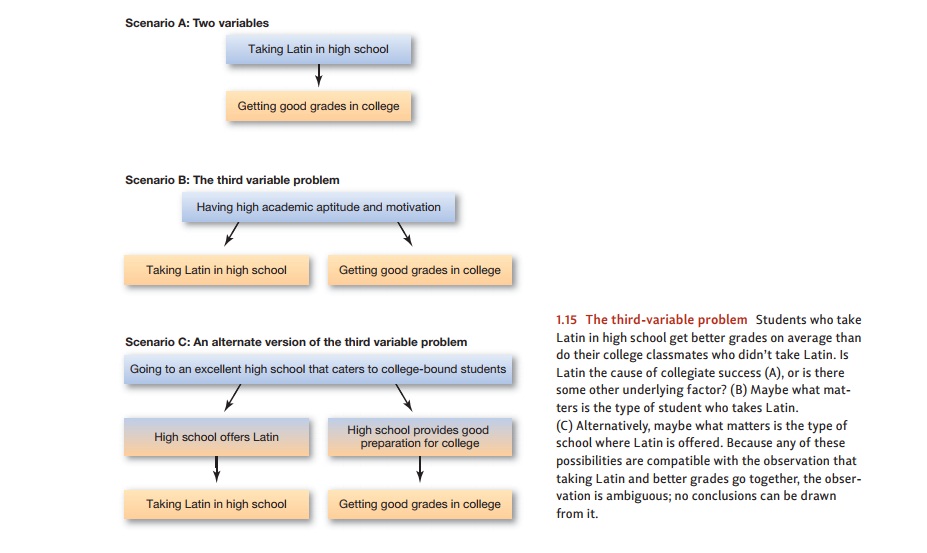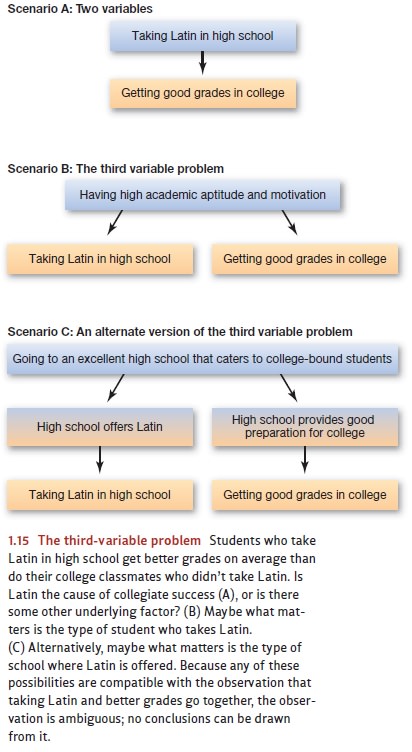Chapter: Psychology: Research Methods
Psychology: Observational Studies

OBSERVATIONAL STUDIES
We’ve now explored some
fundamental tools for psychology research—statistical tools, principles that
govern the definition of variables, and procedures for selecting a sample. But
what can we do with these tools? How do we go about setting up a psy-chological
study? The answer varies considerably, and psychological studies come in many
different forms. In some cases, psychologists observe conditions as they
already exist in the world. Our main example so far—comparing boys and girls in
their level of aggression—has been in this category. This sort of study is
referred to as a quasi-experiment—a
comparison of two or more groups that we did not create; the groups already
existed in the world quite independent of our study.
In other cases, we do correlational studies—we collect
multiple bits of information about each research participant and then examine
the relationships among these bits of information. For example, how important
is it, as we walk through life, to have good self-control—an ability to rein in
our impulses and govern our own thoughts and emo-tions? One study addressed
this broad question by asking people to evaluate various aspects of their own
self-control. Specifically, the participants had to decide how well certain
statements applied to them: “I am good at resisting temptation,” “I am always
on time,” and so on. The investigators also collected other pieces of
information about these same individuals and then looked at the relationships
among these various meas-ures. The data indicated that higher levels of
self-control were associated with better grades in school, fewer symptoms of
mental disorder, less binge eating, and better social relationships (Tangney,
Baumeister, & Boone, 2004). All in all, the study indi-cated the advantages
of self-control and, more broadly, illustrated the sorts of things we can learn
from a correlational study.
Quasi-experiments and
correlational studies are different in important ways (e.g., they usually
require different types of statistical analysis). They are alike, however, because
they both involve data from a natural situation, one that the researcher did
not create. On this basis, we can think of them both as types of observational studies—stud-ies that
observe the world as it is. In a different type of research, though, psychologists
do create (or alter) situations in
order to study them. If, for example, we wanted to ask whether stern warnings
about aggression caused a decrease in bad behaviors, we could give the stern
warning to some children and not to others and then see what happens. In this
case, we’re not studying a previously existing situation; we are adding our own
manipulation—the warnings—to see what this does to the data. Studies of this
sort, involving a change or manipulation, are called experiments.
Ambiguity about Causation
Psychologists often want to study
the effects of factors they cannot control. The inde-pendent variable in our
aggression example—sex—is a good illustration. If we want to learn about the
effect of sex on aggression, therefore, we need to do an observational study,
not an experiment.
Other illustrations are easy to
find. For example, some authors have proposed that birth order is a powerful
influence on personality and that compared to later-born chil-dren, firstborn
children are more likely to identify with their parents and less likely to
rebel. To test this claim, we’ll once again need to study the world as it is
rather than doing an experiment. Plainly, a wide range of issues call for the
use of observational studies; and these studies, when properly designed, are an
important source of evidence for us.
But let’s be clear that observational studies have an important limitation—their ability to tell us about cause and effect. Here’s an example: Suppose a researcher hypothesizes that clinical depression leads to a certain style of thinking in which the person con-stantly mulls over unhappy occasions. To verify this hypothesis, the researcher tests two groups—people who are depressed and people who are not—and has the participants in each group fill out questionnaires designed to assess their thought habits. Let’s suppose further that the researcher finds a difference between the groups—the participants suf-fering from depression are more likely to ruminate on their life difficulties.
How should we think about this
result? It’s possible that depression encourages the habit of rumination; that
would explain why rumination is more likely among people with depression. But,
it’s also possible that cause and effect are the other way around— and so a
tendency toward mulling over life’s problems is actually causing the
depres-sion. That interpretation also fits with the result; but it would have
very different implications for what we might conclude about the roots of
depression as well as how we might try to help people with depression.
In observational studies,
researchers are often uncertain about which variable is the cause and which is
the effect. Worse, sometimes there’s another possibility to consider when
interpreting observational data: Perhaps a third factor, different from the two
cor-related variables, is causing both. This is the third-variable problem (Figure 1.15). For example, a number of studies have suggested that students who
take Latin in high school often get above-average grades in college, and
there’s an obvious cause-and-effect interpretation for these data: Background
in Latin gives students insight into the roots of many modern words, improving
their vocabulary and thus aiding college performance (Figure 1.15A).

This explanation of the data
certainly seems plausible—but it may not be right, and there are surely other
ways to think about the evidence. For example, what sorts of stu-dents
typically choose to take Latin in high school? In many cases, they’re students
who are academically ambitious, motivated, and able. And, of course, students
with these same traits are likely to do well in college. Thus, these students
have distinctive characteristics—motivation and aptitude—that become the “third
variable,” which leads to taking Latin and to getting better grades in college
(Figure 1.15B). On this basis, taking Latin would be associated with good
college grades, but not because one caused the other. Instead, both effects
might be the products of the same underlying cause. (Figure 1.15C illustrates
yet another possibility—and a different notion of what the third variable might
be in this example.)
These complications—identifying
which factor is the cause and which is the effect, and dealing with the
third-variable problem—often make it difficult to interpret obser-vational
data. Researchers often summarize this difficulty with a simple slogan: Correlation does not imply causation. Of
course, sometimes correlations do reflect causal-ity: Smoking cigarettes is
correlated with, and is a cause of, emphysema, lung cancer, and heart disease.
Being depressed is correlated with, and is actually a cause of, sleep
disruption. But correlations often do not imply causes: The number of ashtrays an
indi-vidual owns is correlated with poor health, but not because owning
ashtrays is haz-ardous. Similarly, there’s a correlation between how many
tomatoes a family eats in a month and how late the children in the family go to
bed—but not because eating toma-toes keeps the kids awake. Instead, tomato
eating and late bedtimes are correlated because they’re both more likely to
occur in the summer.
How can we address these
problems? Sometimes we can disentangle cause and effect simply by collecting
more observational data. For example, in the study of depression and thinking
style, we might be able to determine which of these elements was on the scene
first: Were the people depressed before they started to ruminate? Or were they
ruminating before they became depressed? Here, we’re exploiting the simple
logic that the causes must be in place before the effects. In other cases,
though, it’s just not pos-sible to draw conclusions about cause and effect from
observational data, and so we need to turn to a different type of research—one
that relies on experiments.
Related Topics